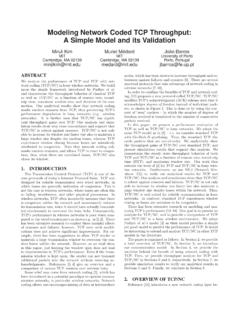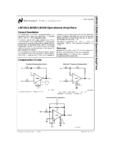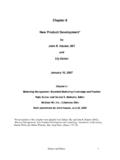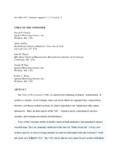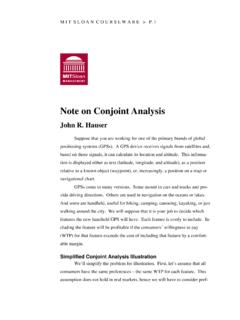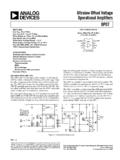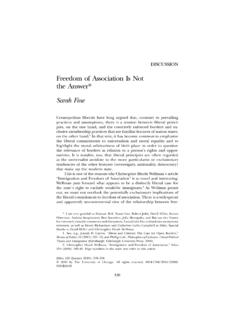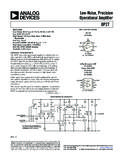Transcription of Metrics: You are What You Measure - mit.edu
1 Metrics: You Are What You Measure ! by John R. Hauser and Gerald M. Katz April 1998 John R. Hauser is the Kirin Professor of Marketing, Massachusetts Institute of Technology, Sloan School of Management, 38 Memorial Drive, E56-314, Cambridge, MA 02142, (617) 253-5056, fax (617) 258-7597, Gerald M. Katz is Vice President of Applied Marketing Science, Inc., 303 Wyman Street, Waltham, MA 02154, (781) 684-1230 x128, fax (781) 684-0075, This research was funded, in part, by the International Center for Research on the Management of Technology (ICRMOT) and by the Center for Innovation in Product Development (CIPD). We wish to thank Robert Klein, Mel Klein, William Lucas, Edward Roberts, and Florian Zettelmeyer for their insights and recommendations on the use of metrics within organizations. Firms use metrics for a variety of laudable purposes. Metrics such as market share, sales increases, margins, and customer satisfaction surveys enable firms to take stock of where they are and to plan for the future.
2 Metrics such as projected revenue, contingent sales forecasts, the net present value of an investment, and the option value of an R&D program provide indicators of future performance. Managers use these metrics to allocate assets and select strategies. Metrics such as an R&D effectiveness index, reductions in the operating cost of a telephone service center, and reduced absenteeism provide the basis for bonuses and promotions for managers and their employees. Our thesis is that every metric, whether it is used explicitly to influence behavior, to evaluate future strategies, or simply to take stock, will affect actions and decisions. If a brand manager knows that, in his or her company s culture, a good brand is a high share brand, he or she will make decisions to maximize market share even if those decisions inadvertently sacrifice long-term profit or adversely affect other brands in the company s portfolio. If an R&D manager knows that projects are chosen based on projected net present value (NPV), he or she will encourage research scientists and engineers to work on programs and make forecasts which make NPV look good even if the NPV calculations are misleading.
3 If a telephone service center manager is rewarded for reduced absenteeism he or she will seek to do well on the firm s Measure of absenteeism even if the Measure does not lead to improved productivity. For example, Kerr (1975) cites a case where the firm measured the number of instances an employee was absent, but not how long they were absent. From a manager s standpoint, if an employee missed a Monday, it was better for the employee to stay out all week than to come back for three days and then miss a Friday. The link is simple. If a firm measures a, b, and c, but not x, y, and z, then managers begin to pay more attention to a, b, and c. Soon those managers who do well on a, b, and c are promoted or are given more responsibilities. Increased pay and bonuses follow. Recognizing these rewards, managers start asking their employees to make decisions and take actions that improve the metrics. (Often, they don t even need to ask!) Soon the entire organization is focused on ways to improve the metrics.
4 The firm gains core strengths in producing a, b, and c. The firm becomes what it measures. If maximizing a, b, and c leads to long-term profit, the metrics are effective. If a, b, and c lead to counterproductive decisions and actions, then the metrics have failed. But it is even Metrics: You Are What You Measure ! Page 2 worse! Once the enterprise is committed to these metrics, the metrics gain tremendous inertia. Those who know how to maximize a, b, and c fear to change course. It is extremely hard to refocus the enterprise on new goals. Choosing the right metrics is critical to success, but the road to good metrics is fraught with pitfalls. We recently worked with a credit card company to improve its products and services. This company had a long-standing tradition of using metrics, displaying more than 100 different measures in their lobby for all to see. One critical metric focused on the quality of the plastic used in their credit cards no bubbles or blemishes were tolerated.
5 But after talking to customers, we found that customers never noticed the blemishes as long as the magnetic strip on the back worked. On the other hand, customers were extremely concerned with other aspects of the service. By focusing on the quality of the plastic, the company was diverting resources away from issues that mattered to customers. By truly listening to and understanding the customer, we helped this company reduce the number of their metrics by more than half and refocus efforts toward those aspects of the service which increased revenues and enhanced profit. This paper focuses on the selection of good metrics. There is no magic bullet. Many metrics seem right and are easy to Measure , but have subtle, counter-productive consequences. Other metrics are more difficult to Measure , but focus the enterprise on those decisions and actions that are critical to success. We suggest how to identify metrics that achieve balance in these effects and enhance long-term profitability.
6 To gain an understanding of the properties of good metrics we begin with a summary of how metrics fail. These seven pitfalls provide examples of where metrics have produced counter-productive results. We then suggest a seven-step system to design effective, lean metrics. We base our recommendations on our own experience and on concepts drawn from the quality movement, from product and service design, from organizational studies, and from recent management theory. These concepts include The Voice of the Customer, The Voice of the Employee, the House of Quality matrix (drawn from the Quality Function Deployment [QFD] process), metrics tracking, employee involvement, and creative management. Seven Pitfalls That Lead to Counter-Productive Metrics Metrics: You Are What You Measure ! Page 3 A good metric is precise, tied to overall profit, applicable to all employees, and designed to encourage extranormal effort or is it? These are all desirable properties, but if pushed to their limits, they lead to counterproductive actions.
7 In this section we highlight seven pitfalls that we have seen in practice. Wherever possible we back up these recommendations with citations from the academic literature. Pitfall 1. Delaying Rewards It is rational for any employee or manager to be more short-term oriented than the firm. Managers and employees change jobs or are promoted. They may not be around to collect future rewards. A manager or employee might do his or her job well and it might maximize long-term profit, but it might be hard to tie that profit back to that manager or employee. Change happens. Promises of future rewards might never be fulfilled. People have mortgages, face college tuition, and have other pressing needs. All of these phenomena imply that any rewards which depend upon future outcomes will be discounted more by managers and employees than by the firm. In the present, when the actions and decisions are being made, rewards will be under-valued if they occur too far in the future. Metrics such as 10-year sales, 5-year revenue, long-term cost reductions, reduced lifetime product development costs, or defects discovered over the life of the product, all delay rewards and bias employees toward decisions and actions that have shorter-term payoffs.
8 To avoid this pitfall, you should look for metrics that can be measured today but which impact future outcomes. For example, Hauser, Simester, and Wernerfelt (1994) show how measures of customer satisfaction can be used to encourage customer-contact employees to make the right tradeoffs between actions and decisions that have immediate impact and those that have enduring long-term impact. By right, we mean that the employees make tradeoffs that maximize long-term profit to the firm. Pitfall 2. Using Risky Rewards It is much more difficult for individual managers and employees to diversify risk than it is for the While few managers and employees bear all the risk resulting from their actions and decisions, they do bear some. A business unit manager expects praise, promotions, and, 1 Even if the firm cannot diversify risk, investors in publicly traded firms can diversify risk in the stock market. Metrics: You Are What You Measure !
9 Page 4 perhaps, bonuses, if the business unit does well on sales, revenue, or profit targets. An employee expects praise, promotions, and bonuses if his or her product development team develops a successful new product. Any metric that depends on an uncertain outcome from influences that are beyond their control imposes risk on the manager or employee. Managers and employees who cannot diversify this risk are likely to be risk averse. They will value guaranteed outcomes more than risky outcomes even if the risky outcomes have the same expected value to the firm. Put another way, there is a risk cost associated with any metric based on vague or uncertain outcomes that are beyond the control of the managers and employees subject to the For example, consider the R&D effectiveness index, EI, proposed by McGrath and Romeri (1994). This index, roughly equal to the percent of profit obtained from new products divided by the percent of revenue spent on R&D, attempts to Measure R&D effectiveness based on the net revenue that R&D contributes to the But R&D is one of the most risky and long-term investments that the firm can make.
10 If managers and employees perceive that they are rewarded based on EI, then they will prefer projects that are less risky (and more short-term oriented). This effect can be huge. Hauser (1998) demonstrates that a significant fraction of R&D projects can be falsely rejected or falsely selected if EI is the only metric. He shows further that a firm can balance this effect by placing a smaller reward on EI and a larger one on other metrics that are less risky to the individual researcher. Fortunately, some firms are experimenting with metrics that allow them to manage risk through the use of options. See Mitchell and Hamilton (1988) and Faulkner (1996). In an analogy to financial options ( , Black and Scholes 1973), metrics are used to reward upside potential while limiting the firm s downside risk. Naturally, these metrics assume that the firm has the discipline to de-escalate commitments when necessary (Boulding, et. al. 1997, Simonson and Staw 1992, Staw 1976). Pitfall 3. Making Metrics Hard to Control Consider the engineering team charged with the design of the door for a new automobile.
